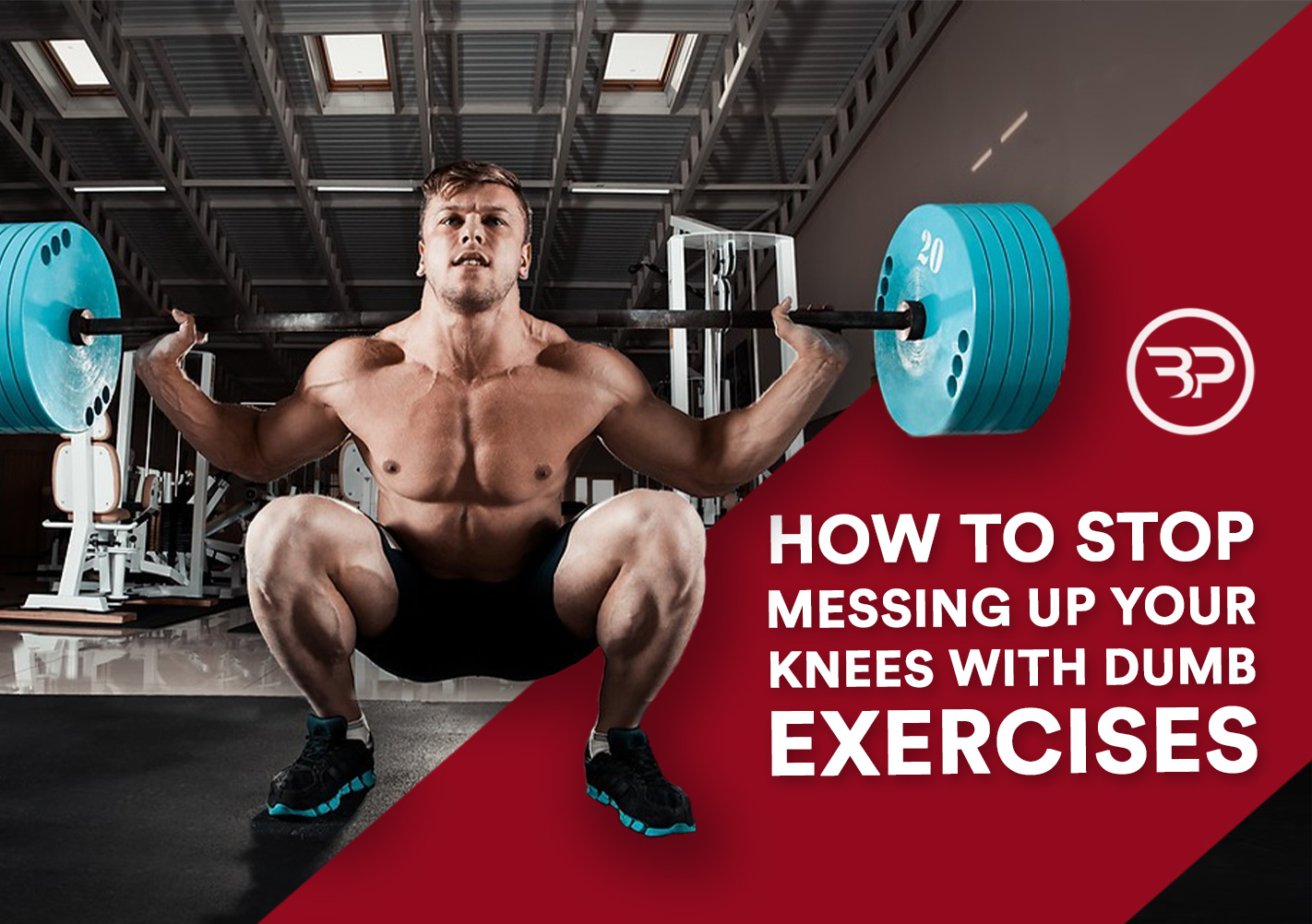How To Stop Messing Up Your Knees With Dumb Exercises
February 22, 2018
Guest Post By Jordan Barnard
Healthy knees are so important that you don’t want to mess them up with dumb exercises. Your performance in the gym will suffer, and so could your everyday life outside the gym.
Here’s what to avoid. And here’s how to perform the right knee exercises the right way: safely and effectively.
Stop Jacking Up Your Knees
As a trainer, I’ve seen it too many times. Someone comes into the gym absolutely pumped to carry out a fitness program. Then they get sidelined by knee pain, miss a few workouts, and disappear — all before reaching their goals.
What brings about this knee pain? You’re doing an exercise with poor technique again and again; usually without realizing it.
Correct exercise form is critical. You’ll get the most benefit out of an exercise. You’ll also lower your risk of injury. Here are some of the most common exercise mistakes people make that lead to knee pain, and how to correct them:
Squats
First up is the squat.
The squat is one of the most effective exercises to lose weight and get stronger because it recruits more muscle groups than almost any other exercise. But incorrect form can be a ticking time bomb that eventually explodes in knee pain.
One of the most common squat mistakes is to push forward during the lowering portion of the movement. Don’t have your weight on your toes, pushing your knees forward, and letting your heels coming off the ground. This is shown in the first few reps on the video below, followed by a few reps done with correct form.
https://www.youtube.com/watch?v=iIGDStcAl3k&feature=youtu.be
Squats like this put all of your weight (plus any weight you’re holding) forward onto your knees, instead of distributed equally across your lower body. You create a stressful joint position when your knees are pushed out in front of the body, loaded with weight.
Why does squatting like this make the movement less effective? It this forces more recruitment of the quads, and less of the other muscles in your legs.
A proper squat calls into action all the muscles of the lower body, including your glutes, hamstrings, and calves, and quads. So if you want everyone to know you “don’t skip leg day,” you need to make sure you are squatting with proper form.
Enough of the bad part. Let’s get to how to squat safely and for maximum benefit.
- In the video above the second set of squats show how to safely perform the movement. Here are the highlights.
- My feet are around hip-to-shoulder width apart; pushing my weight onto my heels and the outsides of my feet.
- I squeeze my shoulder blades back and together. This keeps my back flat and helps protect my spin. (Think about making sure someone in front of you can see the logo on your shirt)
- I start the squat by pushing my hips back and down. It’s like I’m sitting down onto a chair. Forgetting to push the hips back is the most common mistake here.
- I squat down to about where my hips and knees are at the same height (you’ll hear this called squatting to parallel). You can squat deeper than that if you can maintain good form, but it may take time to get to that point.
- To stand back up, push through your heels to come back into a straight standing position.
Lunges
Lunges are an incredibly valuable exercise. Like squats, they work a lot of muscles throughout the body, which is fantastic for fat burning and getting stronger.
They also help us with mobility. The lunge is a movement that many people struggle with after years of sitting at desks or in cars, even though they used to be able to do them easily. Improving mobility like this can lead to a lot of great benefits. You can move with less pain and do more everyday activities.
The most common issue with the lunge is pushing your knees too far out in front and putting most of your weight too far forward. Stressing your lower back comes into play when you push forward with your upper body.
In this video, I talk through what it looks like when making these common mistakes and show correct form.
https://www.youtube.com/watch?v=zXyyejDKA8Q&feature=youtu.be
How are lunges less effective when done with improper form?
You’ll be using fewer muscles to perform the movement, which means few calories burned and less strength being built. When your knee drifts too far forward, you won’t be able to use the glutes and hamstrings as effectively. And when you push your upper body forward, you not only stress your lower back, but also take your core muscles out of the exercise as well. (Yes, your abs are involved during lunges).
Here are the highlights of a safe and effective lunge (I’ll use the reverse lunge for the example):
- Front foot flat on the ground and back foot on the ball of the foot. Both feet have toes pointed straight ahead.
- The distance your feet are apart needs to be big enough that when you lower your back knee towards the ground your front knee will be directly over your ankle, making a 90-degree angle.
- Keep your shoulders over your hips by squeezing the shoulder blades back and together. This is what gets your core involved and protects your lower back.
- Lower your back knee down towards the ground with control. To come back up, push your front foot into the ground
Jumping Exercises
Last up are jumping exercises.
These are full body exercises that give you tons of bang for your buck. They’ll have you sweating, breathing hard, and feeling them later. So it’s no surprise jumping exercises are used all the time in group exercise classes. Unfortunately, they’re often done incorrectly. The result? Pain and missed workouts.
The impact of jumping exercises like burpees, squat jumps, or box jumps can really beat up your joints if you don’t use a safe landing technique. There are two very common mistakes with landing in jumping exercises:
First, landing with your legs completely straight. This sends that impact straight through your body with no way to absorb it.
Second, pushing your knees forward when you land. You’ll come up onto your toes. This again puts all of that pressure on your knees. It’s vital to correct the added impact from the jump.
In this video below I demonstrate incorrect landing technique (locked legs) and then safe landing technique.
https://www.youtube.com/watch?v=tkquyOi-GXU&feature=youtu.be
Here are the highlights of safe landing for jumps:
- Land with your feet around hip-width apart.
- Push down through your heels so that you don’t come forward onto your knees.
- Absorb the impact of the landing by pushing your hips back and down (like a squat).
The Takeaway
Practice safe exercise technique to stay active and pain-free for the long haul.
Check your form regularly. Some of the mistakes that will eventually lead to pain may not hurt at first. There’s no reason to do an exercise in an unsafe manner with the goal of lifting more weight or performing more reps. Unless you’re a professional athlete, the risk is simply too high.
Watch the videos above. Then perform the exercises on your own in front of a mirror or while recording yourself. You’ll identify and correct form mistakes and keep yourself healthy and active for years to come.
For much more on all this and more, please download my Non-Scary Guide to Resistance Training HERE
About the Author

Jordan Barnard is an online personal trainer who can work with you from anywhere in the world so you can get into the best shape of your life. Jordan is a certified online trainer, a certified personal trainer through the National Academy of Sports Medicine, Precision Nutrition certified coach, and has a Bachelor’s degree in Biology from Kennesaw State University. Check out Jordan’s Website or find him on Facebook.









[…] Source link […]